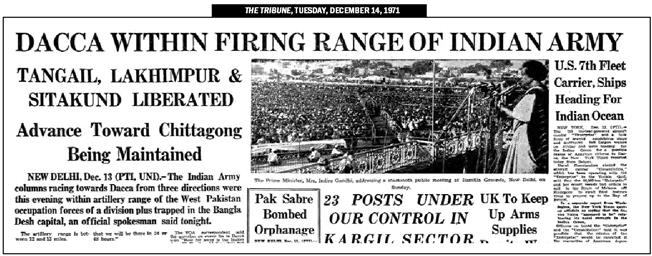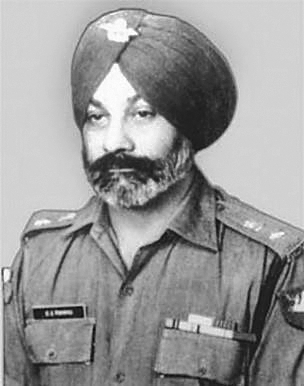
Sujan Dutta
Fabric is synonymous with the name of Tangail. The warp and weft of the Tangail saree is known in every Bengali home and the wider world of women who drape the garment. Whether it is cotton or silk or a mix of the two, the Tangail saree, known for its plain body and rich border, handloomed by generations of weavers is now generic.

Fabric covered the skies over Tangail, the town the saree is named after, 90-odd kilometres north-west of Dhaka in the early evening of December 11, 1971. Ripstop nylon billowed like domes of military green as Indian soldiers of the 2 Para battalion group made what remains the only airborne operation of its kind led by a commander who was the first out of an Indian Air Force cargo plane with his jeep.
In three days, Lt Colonel Kulwant Singh Pannu, later Major General, would also walk into the Dacca International Hotel, take a wash, and then the “flamboyant Commanding Officer of 2 Para spoke to reporters”, according to military historian Arjun Subramaniam, who has seen the unit’s archives. The hotel was designated a safe zone by the United Nations and the Red Cross.
Two days later, Pannu would also bound off the jeep after parking in the grounds of the headquarters of Pakistan’s eastern command, brush past a stern sentry with his adjutant Capt Nirbhay Sharma and the Bangladesh Mukti Bahini leading light Kader ‘Tiger’ Siddiqui and hand over to AAK Niazi a message from General Nagra: “Abdullah,” it said, “it’s game over, surrender.”
(Major General GC Nagra headed the 101 Communications Zone and knew Niazi).
In the time that it took to jump out of the Indian Air Force C-119 ‘Packet’ and park the jeep in Dhaka Cantonment, Lt Col Pannu and his men had passed into legion, their exploits forever in texts studied by professional soldiers.
“I was returning to Tangail from one of our headquarters at Mohanandapur village when the Indian Army paratroopers started landing near Poongli,” wrote Anwarul Ham, a former ambassador and then second-in-command of the Mukti Bahini in Tangail.
“It was quite a sight. I was 1.5 miles away and I ran to greet them. I introduced myself to Lt Col Pannu. He made two requests: to disperse the crowd of villagers (who were gawking) and to arrange for local volunteers to help carry the load and push the artillery guns and jeeps to the road.”
Three of the four guns had fallen into ponds. One landed on the roof of a village house. The battalion group that had landed comprised elements of a field battery and medics. The drop was spread over a wide area, by one estimate over 20 km.
It was tasked to secure the Poongli bridge and the adjacent ferry on the Louhajang river that branched from the wide Jamuna. Securing the bridge would cut off battalions of Pakistan’s 93 Brigade that were falling back to Tangail and Dhaka from Mymensingh and Jamalpur. The operation was deep behind enemy lines, the battalion group having flown from Kalaikunda and Dum Dum in West Bengal. They had linked up with 1 Maratha Light Infantry, who were already in the thick of operations battling their way through East Pakistan from Tura in Meghalaya.
To fulfil his brief, Pannu had to rally round his men and equipment, moving in a wide arc as night fell. Having rounded up a bulk of his men, he prepared to take the bridge. Four artillery guns could be made operational for the charge. Most of the Pakistanis fled but that same night there were three counter-attacks on Poongli bridge.
“I came face to face with bone-chilling scenes of last night’s battle. Corpses of hundreds of enemy soldiers littered the road, bodies from one side of the bridge to another. We walked with care so as to not step on the dead,” wrote Dr Nuran Nabi, a lieutenant of Tiger Siddiqui’s force in Dhaka’s ‘The Daily Star,’ some 30 years after the event.
The 2 Para group, having linked up with 1 Maratha Light Infantry, then rolled cautiously towards Dhaka on the Mirzapur-Jaydebpur Road, reaching Milestone 26, its destination, by the evening of December 15. They were then tasked to turn west and reach Dhaka through the Mirpur bridge. The bridge was staunchly defended even though, by December 15, the war was collapsing for Pakistan.
“We lost three — killed in action. There were 41 enemy casualties but we were at the gates of Dhaka by midnight,” Nirbhay Sharma, who was adjutant to Pannu and who retired as a Lieutenant General (and then became Governor of Arunachal and Mizoram), has written and said in multiple interviews.
The next day, Pannu, Sharma and Tiger Siddiqui were to take the message to Niazi. Pannu, who had tied up with Tiger Siddiqui after the airdrop in Tangail, had taken him along on the battles through to Dhaka. He wanted him along not only for the camaraderie they had struck, but also because of the clear idea drilled into Indian officers that this was not a country they were to occupy but help the Mukti Bahini.
Such was fate, however, for the men who fought alongside that Tiger Siddiqui had to be arrested by the Indian Army in later weeks for having publicly bayoneted surrendered Razakars (Pakistan’s collaborators) personally in the cricket stadium, an incident that was filmed.
Before the entry to Dhaka cantonment, however, the Indian Army’s Eastern Command Chief of Staff, Lt Gen JFR Jacob, had proclaimed from Calcutta that Indian paratroopers had surrounded the East Pakistan capital. Even if it was an overstatement, it carried weight because by that time Lt General Sagat Singh’s forces from the east had crossed the Meghna river.
The 2 Paras led by Pannu were among the first to actually march into Dhaka and extract that famous confession from Niazi. Niazi could not meet Pannu’s gaze, wrote Nirbhay Sharma. He was unshaven — “Pindi mein baithe haramzadon ne marwadiya. The (expletive) people in Rawalpindi, Pakistan’s General Headquarters, have betrayed me with false promises of help.”
The remarkable thing about Pannu’s leadership was that the Indian Army had only one officer with personal experience of an airborne operation till then: Lt Gen Inder Singh Gill, who as a Lieutenant was a commando in Greece for the Allied Forces in 1942. He was Director of Military Operations at Army Headquarters in 1971.
Lt Col KS Pannu’s MVC citation reads:
“Lieutenant Colonel KS Pannu was commanding a battalion, which was airdropped near Tangail on December 11, 1971. The task involved cutting enemy routes of withdrawal and preventing his build-up at Tangail. This also involved the capture of an enemy position on a vital bridge at Poongli. The drop of the battalion was widely dispersed and Lieutenant Colonel Pannu had to move from one location to another under enemy fire to collect his platoons. It was entirely due to his cool courage, utter disregard for his personal safety and his timely and skilful direction that his battalion captured the enemy position at Poongli.
Under his able leadership, the battalion repulsed numerous counter-attacks, inflicting heavy casualties on the enemy. Lieutenant Colonel Pannu displayed conspicuous gallantry, exemplary leadership, determination and devotion to duty in keeping with the best traditions of the Army.”
Join Whatsapp Channel of The Tribune for latest updates.



























